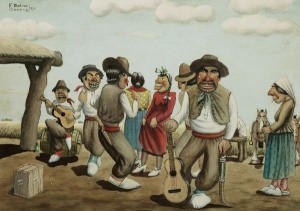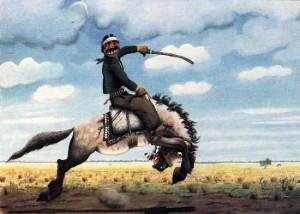 Coronil, Fernando and Julie Skurski, eds. 2006. States of Violence. Ann Arbor, MI: University of Michigan Press. [Ch. 1-3]
Coronil, Fernando and Julie Skurski, eds. 2006. States of Violence. Ann Arbor, MI: University of Michigan Press. [Ch. 1-3]
This brilliant collection edited by Fernando Coronil and Julie Skurski critiques one of the main stories that modernity likes to tell about itself: The rise of modern nations entailed the containment of violence through the monopolization of violence by the state. In fact, show the authors of these essays, the making and transformation of modern nations was—and continues to be—an incredibly violent process. “By illuminating the links between violent ruptures and the routine maintenance of order, [the essays] expand as much as they redefine the conceptual field within which political violence is viewed. Seen from this perspective, practices and discourses of violence, like currents that shape the ocean floor, sculpt social landscapes, imperceptibly chiseling their configuration and casting life chances” (3).
In the introductory essay, Coronil and Skurski draw on Walter Benjamin’s work to explore both the ordinary and extraordinary makings and intersections of violence, power, the state, and memory. But they add to this an analysis that takes colonialism centrally into account; this approach questions “sharp distinctions between states of normality and of exception, and makes it necessary to consider the possibilities opened by violence in light of an already existing global order of differences; an approach attentive to colonial relations pluralizes and further politicizes the connections among violence, potentiality, and ethics” (8).
The authors are strongly critical of how modernity has counterposed—and scholars have echoed—the state and violence, while law, regulatory practices, and the state’s use of force are seen as the other side of the coin. (They cite Foucault as a problematic example of this narrative.) “State violence in the multiple forms that accompany nationalism and colonialism, both internal and external, becomes normalized as the necessary hand of modernity” (11).
The essays are also highly attentive to the spatial dimensions of “states of violence”:
Through their attention to the spatial, the essays here show that just as violence is located in spaces saturated with particular histories, these histories are shaped by the spaces in which they develop; they allow us to analyze, in Doreen Massey’s terms, the relationship between the social construction of space and the spatial construction of the social (1994: 254). Spaces of violence may be distant from centers of state control or reside on their internal frontiers; they may be closely regulated public sites or human bodies defined in spatial terms. Whether cast as an opposition between centers of state reason and peripheries of disorderly backwardness (Baretta and Markoff, Edwards), as the threat of subversion and anarchy within zones of conflict (Cassia, Coronil and Skurski, Feldman), or as the need to confine and classify transgressive figures (Bright, Das, Moodie), the conceptualization and organization of the spatial is integral to the formation of violence. (15)
Another spatial dimension shared by many of the essays is the discourse of civilization and barbarism and, by extension, frontiers. Frontiers are state fixations that are produced by the view of their populations as somehow problematic—and often, as borderline or outright fugitives (gauchos, cowboys, bandits, natives, etc.). “In the official histories of Latin American and European nations, bandits and other frontier populations appear as an obstacle to the nation’s progress, while the structural conditions that shaped them and the moral codes they lived by are ignored” (19).
Discourses surrounding nation-building and state-making—both of which encompass frontier discourses—are also deeply gendered. In the essays, the links between masculinity and violence are particularly apparent. “They show that both imperial states and anti-colonial nationalisms have linked constructs of masculinity to the state in their efforts to mobilize support and to configure an ideal collective identity” (22).
 Silvio Duncan Baretta and John Markoff’s essay on the cattle frontier in the making of Latin American centers and peripheries includes many of the trends cited above—except for gender, though their mention of “honor” begs it. For them, frontiers are places where no one has a monopoly of violence. The racial construction of frontier populations was a central part of their equation with barbarism, facilitating their criminalization by newly independent Latin American states. Frontier people were also stigmatized as vagrants and wanderers, though “vagrant” economies were firmly entwined with “sedentary” ones—often, through licit/illicit channels.
Silvio Duncan Baretta and John Markoff’s essay on the cattle frontier in the making of Latin American centers and peripheries includes many of the trends cited above—except for gender, though their mention of “honor” begs it. For them, frontiers are places where no one has a monopoly of violence. The racial construction of frontier populations was a central part of their equation with barbarism, facilitating their criminalization by newly independent Latin American states. Frontier people were also stigmatized as vagrants and wanderers, though “vagrant” economies were firmly entwined with “sedentary” ones—often, through licit/illicit channels.
They show “how particular forms of social organization and economic enterprise grew around these basic elements; how violence was exploited for purposes of economic gain; how cattle-raising skills were transferred to the realms of banditry and primitive and how violence became, paradoxically, a means of integration in frontier communities. We have also attempted to show that there was no sharp cleavage to be drawn on the frontiers between peon and gaucho, bandit and ranchhand, smuggler and policeman” (58). The frontier was a place of both freedom and servitude (79).

Pingback: Fernando Coronil, R.I.P. | Territorial Masquerades